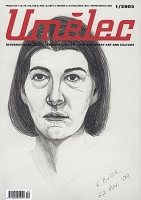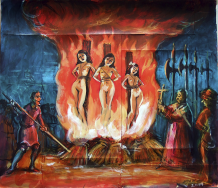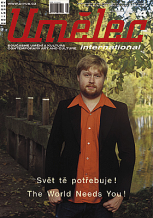| Zeitschrift Umělec 2005/1 >> All Dolled Up | Übersicht aller Ausgaben | ||||||||||||
|
|||||||||||||
All Dolled UpZeitschrift Umělec 2005/101.01.2005 Lenka Klodová | phenomenon | en cs |
|||||||||||||
|
Why is it that something that might be simply a toy, a doll, can play such an influential role in the formation of young girls and even sometimes continue to fill a need in the emotional psyche of women?
“Kiss me baby and Kiss Kiss Baby are selling well and everyone seems to love them...” from an open letter by P. Heath to collectors Dolls. And Playing with them too—they may very well be the most sophisticated tool the patriarchy has to oppress girls and women. That constant reminding that girls are supposed to play with dolls should instill a deeply rooted instinct. Many feminist-oriented thinkers have already accented the formative and determinative nature of socially acceptable and preferred children’s games. Boys race in cars, build houses and play Indians; girls push baby carriages and feed, wrap up and tend to their dolls. The care that society devotes to the preparation of girls for their role as mother is very intense. But dolls also have different functions. Girls don’t own only baby dolls; they also have beautiful dolls - models. The blinking doll with long lashes represents the girls’ future, their future image. After “doll time” as an imitation of the mother, the stereotyping continues as girls themselves become dolls. They care for themselves, make themselves beautiful, and eat daintily. They start refusing to take part in overactive games and overly wild movement, and they sit around esthetically, smiling while trying to apply their decorative qualities. The main goal and effect of the whole effort is reproduction; the customs go hand in hand with the biological instinct for reproduction. All the acquired instincts, all the mobilized potential is realized in motherhood and the subsequent care of the child, therefore fulfilling its natural utilization. The woman has been preparing herself and been prepared for this role since childhood, but the culmination of this preparation and its fulfillment is realized in the first third of her life. But the learned instincts, which correspond with the inner and emotional needs don’t disappear when motherhood is fulfilled. They don’t go away during puberty, with the moment, when the little cute and dependant darling becomes a head taller, and changes into an arrogant individual with a coarse voice. To avoid pathological situations, the woman must liberate the object of her care, she must take a back seat and her emotional needs will be left to sporadically stolen bits. How to solve this malevolency of life, where to turn to with your emotional surpluses? One possible solution is to start collecting art dolls. That’s an expensive solution, but it can bring satisfaction on many levels. “Dear Collectors, August is a sleepy month… Leisandra has proved to be very successful, and we are thrilled that everyone who received her, has written to say how extremely beautiful she is, and of course, that our new prices are much more affordable. Everyone seems to like our website, but we hope to keep it changing and to add new editions and news. For those of you without email, don´t worry, we will continue to send out newsletters, postcards and catalogs of new creations by post, and Rudy and Pilar are always available to answer your telephone calls…” Philip Heath is an exceptional creator in the field of art dolls. His dolls are special in their elaboration and a specific emotional expressiveness. This Englishman living in Valencia uses as models for his art real people encountered on his exotic travels in Africa and Asia, but also in his neighborhood. Each of his dolls is a portrait with a real child as a model, with a real story and wider context. “Dear Marie. I am so pleased you have Lisa II. in your family. Lisa is a little girl I met with her parents in a breakfast cafe in Antwerp. Her name is Lisa DeGroote… We are still in contact and I write to her parents to ask how Lisa is growing and changing. She now has a baby brother!” His art dolls are not universal dummies of happy babies with rosy cheeks. The face of a child and its expression is the most important thing; it gives the artist an impulse to choose it as a model. The portraits are, according to Heath, his open diary, but at the same time he tries to say something more general by the expression rendered. Hardly any doll smiles; their expressions are mostly serious, dreamy and sometimes a bit suspicious with large, serious eyes. They preserve their incomprehensible children’s world. For example the African girl Xima hides in her eyes the ancient soul of the African continent, only living in a young body. The task of the dolls in general is to compensate for the mother instinct, to be a vent for excess feelings and emotions. The work of Philip Heath moves this task of compensation into different levels. Let’s consider what the difference would be if he presented the interesting children from the whole world as sculptures, not as dolls. Why is it important that they have movable arms and legs? The doll, the puppet is an archetypal object, a model of a human being completely resembling humans but lacking its own will and energy. It is an obedient, non-contradicting object for manipulation. The form of a doll invites us to a more intimate and personal approach, which we would never adopt towards a sculpture. The manipulation of the doll doesn’t have to be sexual, as Susan Griffith describes in her study Pornography and Silence. Griffith blames the pornographic products on an effort to make a commodity of real women. Pornography tries to move the image of a woman towards a puppet, an object. An object, unlike a human being hasn’t got its own life; its basic character is its function. Pornography according to Griffith creates an image of a woman – puppet, whose basic function is to please men. On the contrary, art dolls for adult women can in their openness offer an alternative, a certain positive form of manipulation, a kind of a positive voodoo, the possibility of a substitute as compensation. How often can we be much kinder to a picture, a photograph, a doll than to a real person, to a child with all its changes and variability. We don’t feel ashamed in front of dolls, it won’t refuse us; it won’t ridicule our feelings. It doesn’t change, doesn’t get older, so there is no risk that we miss the right moment and lose something important in our relationship with it. Philip Heath adds in his work another level to the complex phenomena of dolls. The upset atmosphere around the dolls is concentrated by choosing models for his dolls in developing countries. This romantic colonial idea is perfected in the concepts Lost and Found and Past and Present. African girls Jewel (2002), Xima (2003) and Alma (2004), Indonesian girl Precious (2003), Ulia from Afghanistan (2003) and Shashiben from India (2004) exist in two versions in the Lost and Found concept. In the Lost Version – the doll is dressed in the traditional clothes of the ethnic tribe or shabby, artificially dirty clothes typical for the given region, and in the Found variety – in lovely clean Western clothes. The author comments on the doll Titi II. From 1997, whose original version Titi I. is dressed in a copy of the original Ashanti clothes including beads which the native people created by pearling glass shards from bottles which remained here after the Europeans: “My Titi II. could be the great-great-granddaughter of Titi I. I have kept the original facial features, but lightened the skintone, lightened and smoothed the hair, and dressed her in a pretty dress that would become any one of the pretty little girls I saw on my visit to a Baptist church in Detroit.” (from the Gotz catalog 1997) Using the media of dolls to romanticize the colonial theme, which we could blame for the exploitation of native African and Asian people on one side affected by merciless globalization and on the other romantically portrayed for the satisfaction of the motherly instinct of German women, changes it into a theme which is in my opinion critical post-colonially. In a different, final form this concept could have features of colonial arrogance. But the form of a doll makes it an interactive affair with a wide possibility of choice and a possibility to show your own expression, with a scale of different reactions and ventilation. So can a collector of art dolls embrace in the African girl Xima not only her grown up child, but the whole developing world as well and via the doll she can take care of an impoverished black child. Philip Heath creates dolls of a high artistic level, he tries to put them to a large degree among the utility articles whose features are preserved, and he wants to bring them closer to free art. This – together with their high price – limits the circle of their owners and users. Therefore the dolls have a certain protection and adequate care. The voodoo, which can be applied to them is surely of a caring and charitable nature.
01.01.2005
Empfohlene Artikel
|
|||||||||||||
|
04.02.2020 10:17
Letošní 50. ročník Art Basel přilákal celkem 93 000 návštěvníků a sběratelů z 80 zemí světa. 290 prémiových galerií představilo umělecká díla od počátku 20. století až po současnost. Hlavní sektor přehlídky, tradičně v prvním patře výstavního prostoru, představil 232 předních galerií z celého světa nabízející umění nejvyšší kvality. Veletrh ukázal vzestupný trend prodeje prostřednictvím galerií jak soukromým sbírkám, tak i institucím. Kromě hlavního veletrhu stály za návštěvu i ty přidružené: Volta, Liste a Photo Basel, k tomu doprovodné programy a výstavy v místních institucích, které kvalitou daleko přesahují hranice města tj. Kunsthalle Basel, Kunstmuseum, Tinguely muzeum nebo Fondation Beyeler.
|





































 New book by I.M.Jirous in English at our online bookshop.
New book by I.M.Jirous in English at our online bookshop.
Kommentar
Der Artikel ist bisher nicht kommentiert wordenNeuen Kommentar einfügen